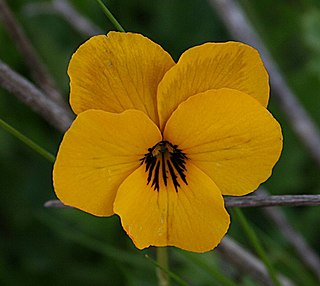
Viola pedunculata, the California golden violet, Johnny jump up, or yellow pansy, is a perennial yellow wildflower of the coast and coastal ranges in California and northwestern Baja California. The common name "Johnny jump up" is usually associated with Viola tricolor however, the introduced garden annual.

Salvia sonomensis is a low-growing perennial plant that is endemic to California.
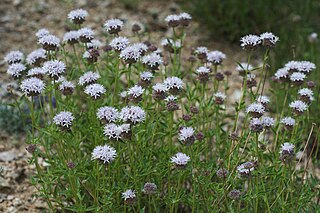
Monardella odoratissima is a perennial flowering plant. It is a member of the mint family Lamiaceae. It has the minty odor characteristic of this family. In 2020, Monardella villosa was included in M. odoratissima. As of April 2024, acceptance of the inclusion varies.
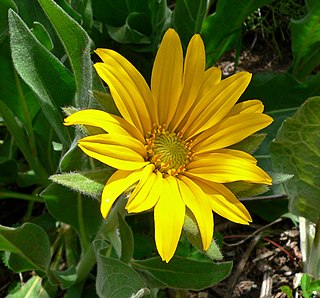
Wyethia is a genus of North American flowering plants in the family Asteraceae. First published by Thomas Nuttall in J. Acad. Nat. Sci. Philadelphia vol.7 on page 39 in 1834.

Balsamorhiza is a genus of plants in the family Asteraceae known commonly as balsamroots. These are perennials with fleshy taproots and caudices bearing erect stems and large, basal leaves. Atop the tall stems are showy yellow sunflower-like blooms. Balsamroots are native to western North America.

Callitriche marginata is a species of aquatic plant known by the common name winged water starwort. Callitriche marginata is native to the west coast of North America from British Columbia to Baja California, where it grows in and around vernal pools.

Madia gracilis is a species of flowering plant in the family Asteraceae known by the common names grassy tarweed, slender tarweed, and gumweed madia.
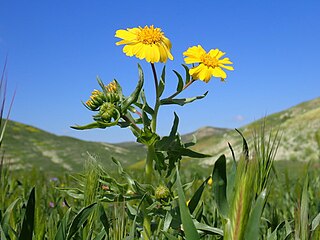
Madia radiata is a species of flowering plant in the family Asteraceae known by the common names golden madia and showy madia. It is endemic to California, where it is known mostly from the Central Coast Ranges and adjacent edges of the San Francisco Bay Area and Central Valley.

Madia sativa, known by the common names coast tarweed and Chilean tarweed, is a species of flowering plant in the family Asteraceae found in parts of western North and South America.

Viburnum ellipticum, the common viburnum or oval-leaved viburnum, is a species of shrub in family Adoxaceae. It is native to the western United States from Washington to central California, where it occurs in forests and mountain chaparral habitat. The shrub has deciduous leaves with oval or rounded blades 2 to 6 centimeters long. The leaf blade usually has three main longitudinal veins and a shallowly toothed edge. The inflorescence is a flat-topped cyme of many white flowers each 6 to 8 millimeters wide with five whiskery white stamens. The fruit is a drupe about a centimeter long.

Viola douglasii is a species of violet known by the common name Douglas' violet, or Douglas' golden violet. It is native to western North America from Oregon through California and into Baja California, where it grows in seasonally moist habitat, often on serpentine soils. This rhizomatous herb produces a cluster of erect stems just a few centimeters in length to about 20 centimeters in maximum height. The leaf blades are deeply dissected into several narrow lobes or compound, made up of leaflets, and borne on long petioles. They are hairless to softly hairy in texture. A solitary flower is borne on a long, upright stem. It has five bright or deep yellow petals with brown veining and brown outer surfaces. The largest lowest petal may be over 2 centimeters in length.

Wyethia angustifolia is a species of flowering plant in the family Asteraceae known by the common names California compassplant and narrowleaf mule's ears. It is native to the west coast of the United States from Washington to California, where it grows in grassland, meadows, and other open habitat. It is a perennial herb growing from a tough taproot and caudex unit and producing a stem 30 to 90 centimeters tall. The leaves have lance-shaped blades up to 50 centimeters tall. The inflorescence produces one or more large sunflower-like flower heads at the top of the hairy stem. The head has narrow, hairy phyllaries at the base. It contains up to 21 yellow ray florets each up to 4.5 centimeters long and many yellow disc florets. The fruit is an achene which may be nearly 2 centimeters long including its pappus.

Agnorhiza bolanderi is a species of flowering plant known by the common name Bolander's mule's ears. It is endemic to California, where it is known only from a narrow section of the Sierra Nevada foothills about 275 kilometers long from Shasta County to Mariposa County. It grows in chaparral and grassland habitat, usually on serpentine soils.

Agnorhiza reticulata, known by the common name El Dorado County mule's ears, is a rare species of flowering plant found only in a small region of north-central California.

Agnorhiza elata is a species of flowering plants known by the common name Hall's mule's ears. It is endemic to California, where it is known only from a section of the central Sierra Nevada foothills. It occurs primarily in a region stretching from Tuolumne County to Fresno County, but a few isolated populations have been found in Tulare County.

Wyethia glabra is a species of flowering plant in the family Asteraceae known by the common name Coast Range mule's ears. It is endemic to California, where it grows in the North and Central Coast Ranges. It is a perennial herb growing from a tough taproot and caudex unit and producing a stem up to 40 centimeters tall. It is hairless to hairy and glandular. The leaves have lance-shaped or oval blades up to 45 centimeters long. The inflorescence is usually a solitary flower head or occasionally a cluster of 2 or more. The head has lance-shaped leaflike phyllaries at the base. It contains up to 21 yellow ray florets each up to 5 centimeters long and many yellow disc florets. The fruit is an achene over a centimeter long, including its pappus.

Agnorhiza invenusta is a species of flowering plant known by the common names Coville's mule's ears and rayless mule's ears. It is found only in California, where it grows in the Sierra Nevada foothills as in Fresno, Tulare, and Kern Counties.
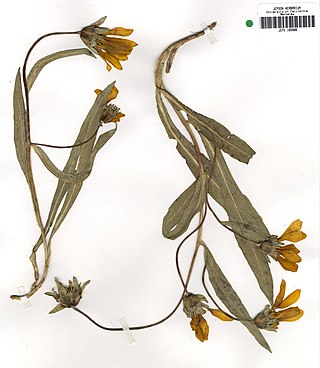
Wyethia longicaulis is a species of flowering plant in the family Asteraceae known by the common name Humboldt mule's ears. It is endemic to California, where it occurs in the North Coast Ranges and the Klamath Mountains. It grows in mountain and foothill habitat such as grassland and forests. It is a perennial herb growing from a tough taproot and caudex unit and producing a stem up to half a meter tall. It is hairless to hairy and glandular. The leaves have lance-shaped or oblong blades up to 20 centimeters long. They are glandular and have a waxy exudate that dries white. The inflorescence is usually a cluster of 2 to 4 flower heads, each with up to 10 yellow ray florets which may be up to 3 centimeters long. The fruit is an achene about a centimeter long, including its tiny pappus.

Agnorhiza ovata is a species of flowering plant known by the common name southern mule's ears. It is native to the mountains and foothills of southern California and Baja California, occurring the Coast Ranges and Sierra Nevada foothills in Tulare, Kern, Ventura, Los Angeles, Orange, Riverside, and San Diego counties in California, with additional populations in the Peninsular Ranges south of the international border.

Wyethia amplexicaulis is a common herbaceous perennial plant from the northwestern United States called northern wyethia, northern mule ears, or black sunflower. Because of its tendency to grow together in dense colonies and its large, showy flowering heads it is a well known western wildflower that is often photographed. It is disliked by range managers because its leaves are not very palatable to large herbivores including livestock.





















